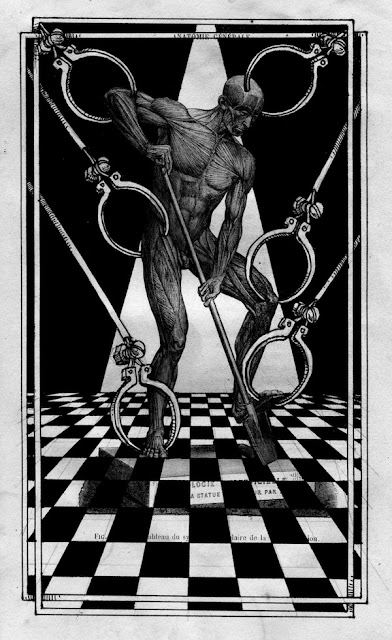ILLUSTRATIONS FROM RESTLESS BOOKS' REISSUE OF THE GOTHIC CLASSIC: Literary Hub
ARTIST STATEMENT BY EKO
Mary Shelley wrote Frankenstein as the scientist M. Cloquet explained in 1816 his Treatise on Descriptive Anatomy, “with scalpel in hand.” I’m drawing the construction of the human being with a pen as sharp as a scalpel, dismembering it in order to create a new body. The Greek artifex challenges the gods once more, and the imagination creates something out of nothing: a humanoid and its story. In this series of ink drawings I use as a base the pages of a French anatomy book from the period during which Mary Shelley wrote her novel; the paper is an artistic setting, historic and aesthetic, and the information and the forms of the letters are Dr. Victor Frankenstein’s laboratory. With my drawings I continue Dr. Frankenstein’s line of thinking and ask the same questions he asks: Is it right for science to create human beings? Is that “creature,” that “monster” the consequence of human arrogance? Is being familiar with anatomy enough to know what it means to be human? Francisco de Goya writes on one of his etchings, “The sleep of reason produces monsters.” This monster is formed with human parts and comes to life with the force of electric energy—but still isn’t human. It’s the product of dreaming, of a delirious mentality. He doesn’t even exist; he is the fear that we have of our own work. My drawings, like the mind of Dr. Frankenstein, start with the delusion of reason. (Traducción de Jackson Saul)
EKO, MANIFIESTO ARTÍSTICO
Mary Shelley escribió Frankenstein como el
científico M. Cloquet desarrolló en 1816
su Tratado de Anatomía Descriptiva,
“con el escalpelo en la mano”. Estoy dibujando la construcción de un ser humano
con una pluma tan filosa como un escalpelo, desmembrándolo para lograr crear un
cuerpo nuevo. El artifex griego vuelve
a retar a los dioses, la imaginación crea algo a partir de la nada: un
humanoide y su historia. En esta serie de dibujos a tinta uso como soporte las
páginas de un tratado francés de anatomía de la época en la que Mary Shelley
escribió su novela, el papel es un escenario artístico, histórico y estético, la
información y las formas de las letras son el laboratorio del doctor Victor Frankenstein.
Con mis dibujos sigo el pensamiento del doctor Frankenstein y hago las mismas preguntas que él se hizo ¿Es
válido que la ciencia haga seres humanos? ¿Esa “criatura” ese “monstruo” es la
consecuencia de la arrogancia humana? ¿Es suficiente conocer la anatomía del
cuerpo para saber qué es un ser humano? Francisco de Goya escribe en uno de sus
grabados “El sueño de la razón produce monstruos”. El monstruo está formado con
partes humanas, adquiere vida con la fuerza de la energía eléctrica y sin
embargo no es humano. Es producto del sueño, del delirio de una mente, no
existe, él es el miedo que tenemos a nuestras propias obras. Mis dibujos, como
la mente del doctor Frankenstein entran en el delirio de la razón.











































